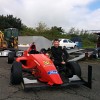I did just one event in 2010 at Colerne before parking it up for the winter. Over the winter before the 2011 season, the car went to H's Garage to be checked over for the new season. A new rear wing from ADR and front splitter from 9mm ply skinned with fibreglass weave reduced weight and (hopefully) increased downforce. A new lithium battery was procured to reduce the weight further (it weighed less than the bracket for the old lead battery and is held in with cable ties) and a Racepak G2X data logging device and new dashboard were installed to allow debugging of the car and driver. Also, the extinguisher was replaced with a slimmer unit so I can take passengers at track days.
At the first event in 2011, I picked up my first class win at the Great Western Sprint, the first round of the British Sprint Championship. No changes before the second round and I ended up being pipped to the post by Angus in his Radical on the last run of the day. Onward to Crystal Palace, and the competition wasn't so fierce in class, so I picked up two easy class wins and 4th/3rd overall. I was disappointed to spin twice on runs that were on target to win the event outright, according to the data from the logger. Inexperience! I went to Anglesey for the British Sprint double-header and lost out again to Angus on both days.
To celebrate 100 years of its existance, Bristol Motor Club held a centenary party with the Dick Mayo Sprint on Saturday, live music on Saturday night and a gathering of interesting cars on the Sunday. I bagged second in a very strong class entry and demonstrated the car on Sunday in the parade laps. Happy Birthday to Bristol Motor Club!
The next event was the Wessex Sprint. Unfortunately, the chain stretched in first practice and whipped the tensioner on the downshift into Tower. I didn't realise what had happened until I got back to the paddock, by which time the tensioner was torn to pieces. I had a new one machined from billet, but it was season over.
Over the winter, I looked into making a new diffuser. I posted on the forum for some advice and cribbed a design in Google Sketchup. Somewhat embarassingly, that's as far as it's got to this day, partly because of time, partly because of skills and partly because the car won't go on the trailer with a bigger diffuser.

There were some big changes over the winter:
- The chain tensioner was fixed so it will tension the chain properly and now straps in place to prevent a failure like the one at Castle Combe last year.
- The rear wing mount was milled out and weight has dropped from 7.75kg to 2.5kg!
- The rear diffuser mounts were lightened too.
- Wishbones intruding into the chassis were covered to protect my legs in the case of an accident or the mounting shearing.
- Differential oil seals replaced.
- Rosejoints on the rear pushrods replaced due to wear.
- Alloy plate under engine and a variety of brackets removed.
- Reverse gear selector permanently secured into forwards.
- Battery re-located.
I did a charity track day at Castle Combe soon after and on the second run, felt a bit of chain slap. I'd not noticed the chain had stretched last year and the work I'd had done on the tensioner was based around a stretched chain. I couldn't fit a new chain, so I went home. I managed to space out the tensioner enough to fit a 14T front sprocket (not the 15T I'd run before), but I can't fit a 13T or a 15T anymore. Gah! Simulations with Bosch LapSim had shown that a 13T is the fastest around Combe (and probably everywhere else) and that a 14T is slower than a 15T because I carry one gear higher everywhere.
I ordered some carbon end plates (450mm x 300mm) from LCM Motorsport to replace the piddly items on my wing. I didn't have time to fit them before the next event at Castle Combe. It was to be a testing time! Coming through Camp on my second timed run, the left rear wheel shattered and flew into the catch fencing. Luckily, it bounced back over the track and into the field, rather than into the packed pit lane. Fortunately, the first run was enough to win the class and finally beat Angus on his first visit to Combe. The car was undamaged other than a few mm lost from the diffuser strakes.
Getting new wheels seemed tricky with a 4" PCD and centre locking. In the end, ADR offered me a deal I couldn't refuse and sold me a set of OZ magnesium wheels and new hubs/discs/calipers to convert the car to Dallara PCD. Unfortunately, it took a while, so I missed Llandow and Clay Pigeon.
Next up was Castle Combe again for the Dick Mayo Sprint and I was hoping for dry weather as I'd not been able to find a set of Dallara wheels to fit my wets. Fortunately, it was dry and my only problem was beating Clive Wooster. He did it again, pipping me on the final run to win the class.
















